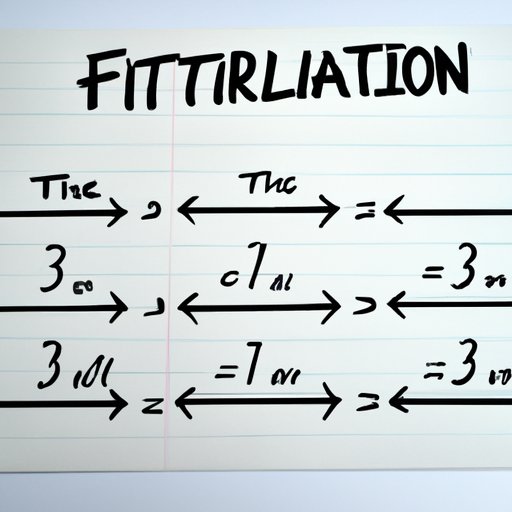
Introduction
Simplifying expressions is an essential skill in elementary algebra, as it helps make complex problems more manageable. It’s important for students to develop this skill to solve equations, graph lines, and perform other fundamental math tasks. In this article, we’ll explore the basics of simplifying expressions, common mistakes to avoid, useful techniques for simplifying expressions, and how to apply them to real-world problems, including using visuals to enhance understanding.
The Basics of Simplifying Expressions
Before diving into techniques, it’s important to understand key terms and concepts related to simplifying expressions. At its core, simplifying an expression involves combining like terms. A term is a group of numbers, variables, and coefficients. In the expression 3x + 2y – 5x, for example, “3x” and “-5x” are terms. Similarly, a coefficient is the number that’s attached to a variable. In “4x,” for instance, the coefficient is 4.
When simplifying expressions, it’s also essential to understand exponents. An exponent is a number written in superscript that indicates how many times the base number or variable is multiplied by itself. For example, in “x^3,” the variable “x” is multiplied by itself three times.
To start with the basics of simplifying expressions, here are some simple problems:
- 2x + 3x = 5x
- 4y – 2y = 2y
These problems demonstrate how combining like terms works. In the first problem, “2x” and “3x” are combined because they are both terms with the same variable. The result is “5x”. Similarly, in the second problem, “4y” and “(-2y)” are combined, giving us “2y”.
To move on to more complex problems, try factoring in expressions or applying exponents and parentheses. For example:
- 3(x+2)+2x = 5x+6
- 4(x^2+y)-2(x^2-y) = 6x^2+6y
It’s important to note that different techniques can be used to simplify different problems.
Common Mistakes to Avoid
There are several common mistakes that students make when simplifying expressions. One of the most frequent errors is forgetting to distribute and incorrectly combining unlike terms. For instance, in the equation “2(3x + 4) = 5x,” some may incorrectly simplify by adding the 2 to the 3x and the 4, which gives us “6x + 8”. This mistake can be avoided by carefully distributing the 2 to both terms within the parentheses, giving us “6x + 8 = 5x.”
Another common mistake involves forgetting or misplacing negative signs. For example, in the expression “4x – 2y + 5x + 3y,” one might mistakenly add like terms and get “9x + y” instead of the correct answer, “9x + y”. To avoid such a mistake, make sure to properly apply the rules for adding and subtracting negative signs.
Techniques for Simplifying Expressions
There are various strategies for simplifying expressions, including combining like terms, distributing, and factoring. The most common of which is combining like terms.
Combining like terms means adding or subtracting the coefficients of terms with the same variable. For instance, in the expression “3x + 5x – 4x,” the coefficient for “x” is 3, 5, and -4. Combining these gives us “4x” since 3x + 5x – 4x = 4x. Similarly, to combine expressions like “6a^2 + 3a^2” the exponents must be the same, and so when added together, we obtain “9a^2”.
An equivalent and useful technique is distributing. Distributing involves multiplying a term outside the parentheses by all the terms inside the parentheses. For instance, in the expression “2(3x + 4),” distribute 2 to each term inside the parentheses to get “6x + 8.” This technique is useful when there is only one variable in an expression, and expansion is feasible for simplification.
Factoring, on the other hand, involves identifying common factors and factoring them out of an expression. For instance, in the expression “6x + 24,” the common factor can be identified as 6, giving us “6(x + 4)” as the simplified form. Factoring can be handy for cleaning up expressions that are sufficiently lengthy, and also for factorization of algebraic equations. Continuous practice of these techniques is crucial to master them.
Real-World Applications of Simplifying Expressions
Simplifying expressions can also be useful for solving real-world problems. For instance, suppose there is a discount of 20% on certain items whose price is $100. Simplify the expression 20% * 100 by first converting 20% to a decimal (0.20) and then multiplying it by 100. This gives us $20 as the discount.
Another great application is for calculating the slope of a line based on two points on the line. The slope is a mathematical measure of the line’s steepness. The formula for determining the slope of a line between two points is given by:
slope = (y2 – y1) / (x2 – x1)
The formula comprises all the basics of algebra, including simplification. The resulting slope will always be a number that measures the line’s steepness between two points.
Using Visuals to Simplify Expressions
Visual aids are instrumental in simplifying expressions, especially for visual learners. They serve as a versatile way to represent and visualize problems. Some example options include diagrams, tables, and charts.
For instance, consider the visual below of the distributive property in action:

The visual shows how the multiplication of the coefficient of the first term distributes across the terms inside the parentheses to give us an expanded expression, (3x + 6).
Practice Problems
To reinforce the material covered in this article, try these practice problems:
- 4(x+2) + 3(x+5)
- 5(a^2 – 2ab + b^2)
- 5x – 2x^2 – 3 + 6x^2
Conclusion
Simplifying expressions is a fundamental skill that lays the groundwork for success in more advanced math courses. By understanding the basics of expression simplification, avoiding common mistakes, and learning techniques for simplifying expressions, students can master the art of simplifying equations, solving equations, and graphing lines to more roficiently tackle real-world challenges. With continued practice and the use of visuals, students can build a solid foundation that will support them throughout their math journey.




